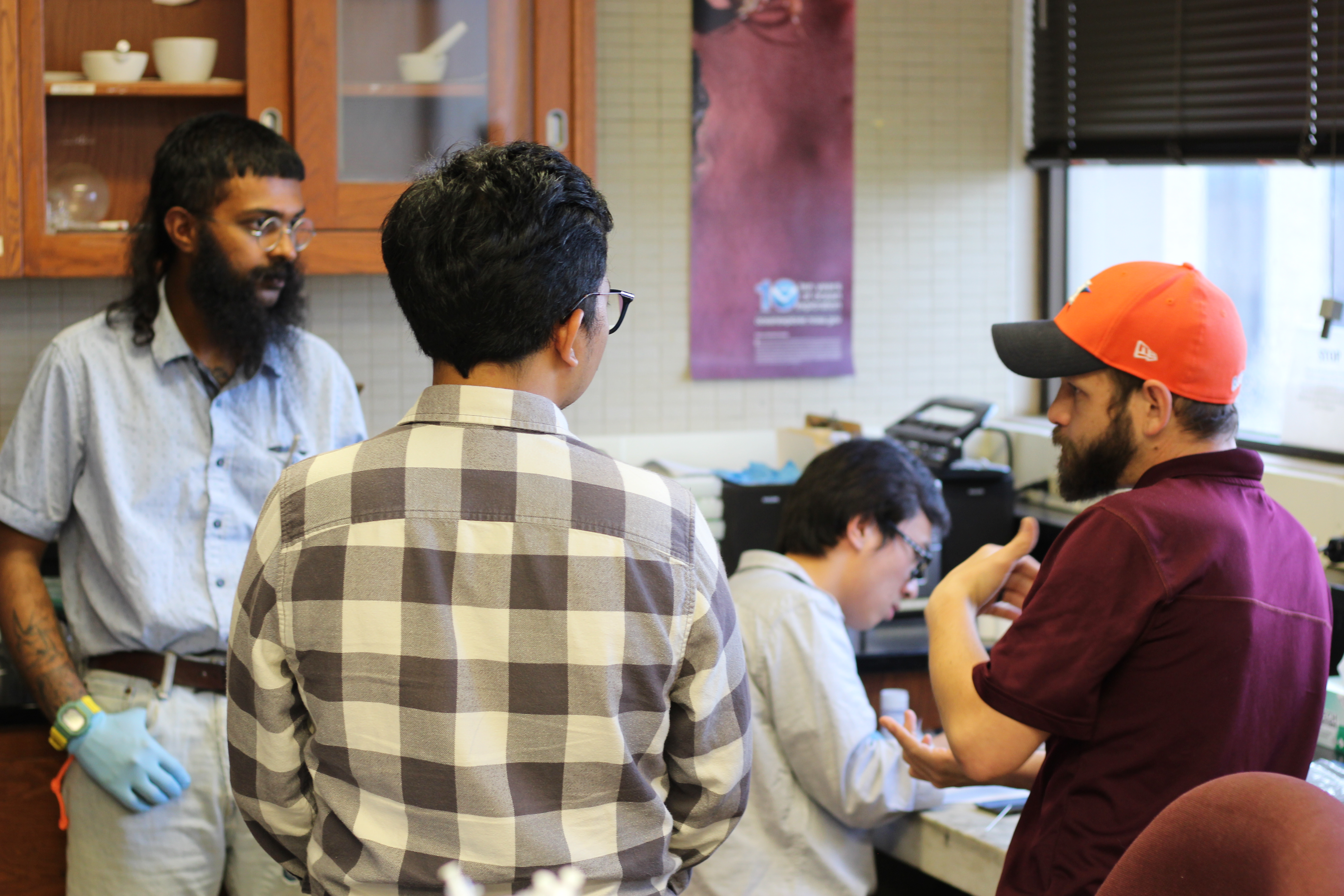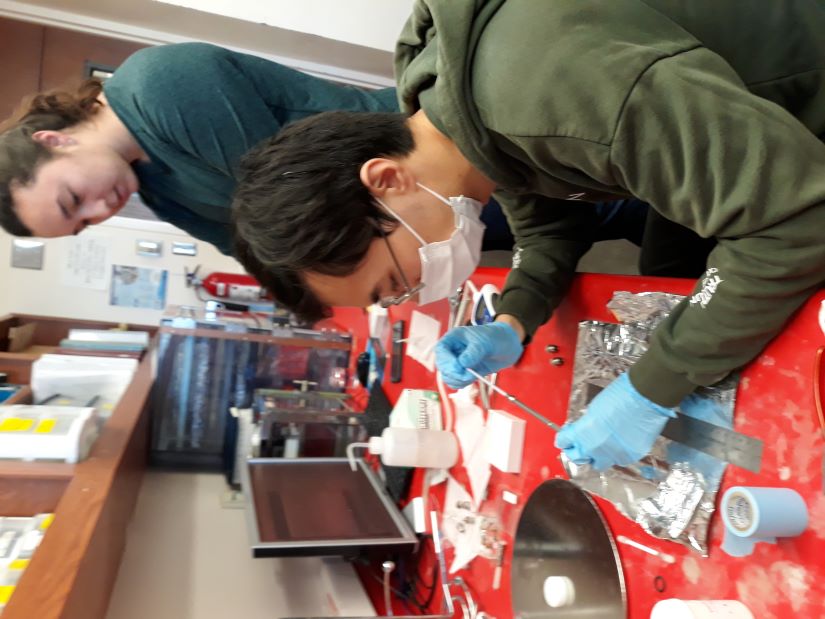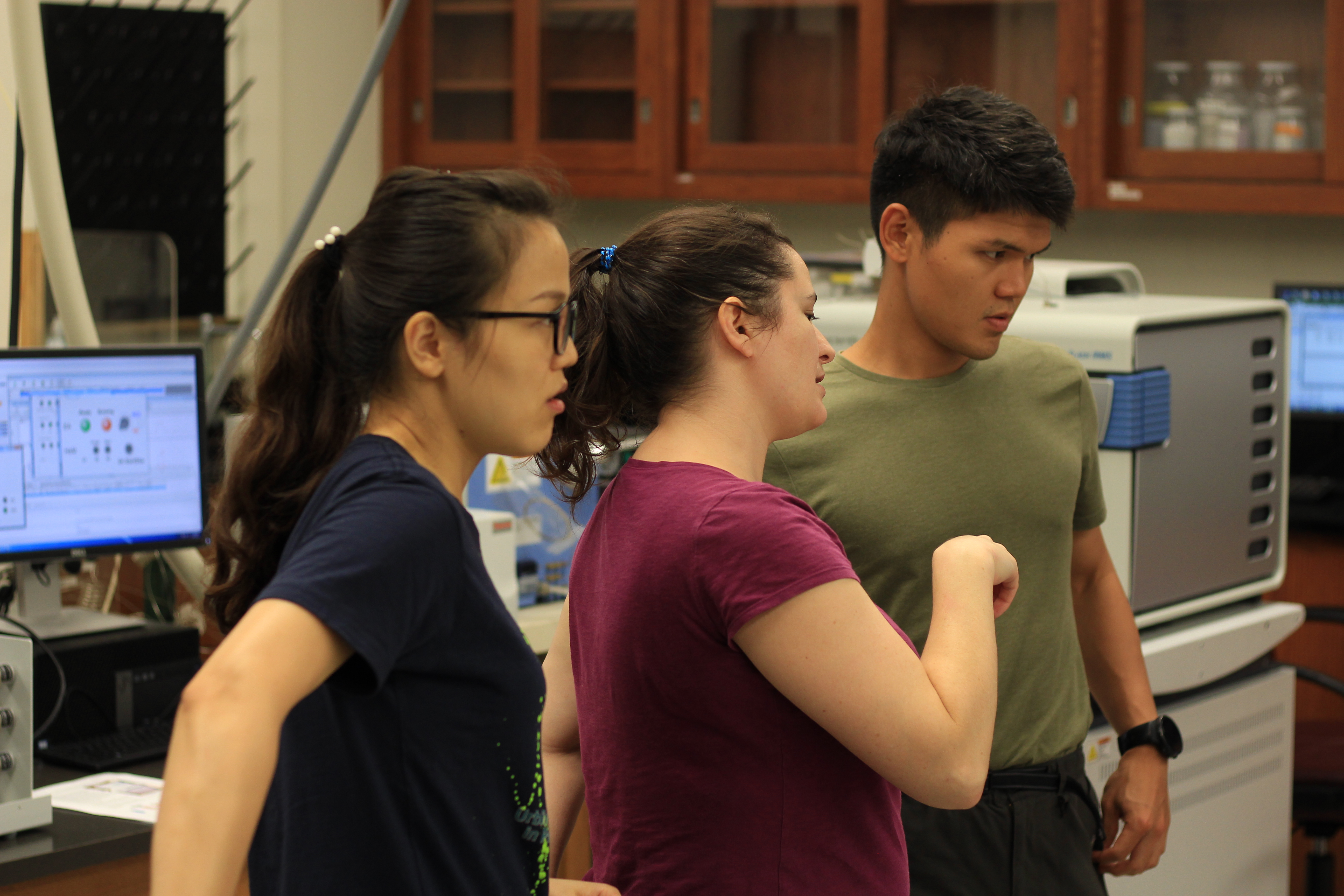Research and Education
Opportunities for Faculty and Students

Stable Isotope Principles
Terminology
Isotope: an isotope is an atom whose nuclei contain the same number of protons but a different number of neutrons than other atoms of that element. Isotopes are broken into two specific types: stable and radioactive. Stable isotopes produced by radioactive decay are also called radiogenic isotopes. There are over 300 known naturally occurring stable isotopes. The Stable Isotope Geosciences Facility (SIGF) focuses on the measurement of naturally-occurring stable isotopes of the following light elements: hydrogen, carbon, nitrogen, oxygen, and sulfur.
Isotopic Abundances: light elements contain different proportions of at least two isotopes. Usually, one isotope is the predominantly abundant isotope. For example, the average natural abundance of 12C is 98.9%, while the average abundance for 13C is 1.1%. Variations in these abundances reveal clues to the origin and cycling of compounds containing the stable isotope (e.g., carbon-containing compounds).
Natural Isotopic Abundances of some light stable isotopes:
Kinetic Fractionation:

Heavy isotopes undergo all of the same chemical reactions as light isotopes, but because they are heavier, they do it slightly slower. These tiny differences in reaction rates cause the products of reactions to have different isotope ratios than the source materials. For example, knowing the carbon and oxygen isotope ratios in plant and animal tissues allows us to know about the processes by which the materials were formed. This can tell if plant roots are tapping recent rain or deep groundwater, the water-use efficiency of whole forests, what an animal has eaten throughout its life, and the global sources and sinks for carbon dioxide in the atmosphere. Historical materials, including those that may be many thousands or millions of years old, can be analyzed in the same manner, allowing us to compare modern and ancient environments. Some other examples of a kinetic isotope processes are evaporation and condensation, diffusion, and dissociation reactions.
Isotopic Fractionation: Isotopic fractionation, or the slight preference of one isotope over another in a compound, causes stable isotopic abundance variations. Fractionation is caused by slight differences in mass-dependent chemical and physical properties of isotopes associated with isotope exchange during chemical reactions. This equilibrium phenomenon yields different isotope ratios depending on temperature, providing a paleothermometer via measurements of the oxygen isotope composition of fossil shells, and records of climate change.
Delta (δ) notation: Isotope abundance ratios (for example, 18O/16O) are reported relative to standards rather than as absolute abundance ratios. The difference in isotopic composition between the sample and standard is determined using this equation:
δ (‰) = [(Rsample-Rstandard)/(Rstandard)] x 1000
Rsample is the isotope ratio of the sample.
Rstandard is the isotope ratio of the internationally accepted reporting standard.
Primary Reference Scales:
V-SMOW (Vienna Standard Mean Ocean Water) – used for δ2H and δ18O
SLAP (Standard Light Antarctic Precipitation) or SLAP2b– used for δ2H and δ18O isotope measurement. The standard is often analyzed as a second standard with VSMOW (or VSMOW2) to correct for data compression
V-PDB (Vienna Pee Dee Belemnite) – used for δ13C measurements and δ18O measurements of carbonate minerals. The standard, calcite (CaCO3-) from a belemnite fossils from the Pee Dee formation in South Carolina, is no longer available. Thus, secondary standards are used (NBS-19 or IAEA-603) that are calibrated to VPDB.
Atmospheric Air – used for δ15N measurement. The air has a very homogeneous isotopic composition making this an ideal reference.
V-CDT (Vienna Canyon Diablo Troilite) - used for δ34S measurement.
International Reference Material Calibration
Typically, samples are measured along with several internal standards as a check on internal instrument precision. These internal standards are usually a matrix standard (which means that we analyze the sample along with a similar matrix standard: plant samples are analyzed with plant standards, animal tissues are measured with animal tissue standards, water samples are measured with water standards, carbonate samples are measured with carbonate standards, etc.). Before analyzing samples along with internal standards, they need to be calibrated for accuracy. For this calibration we use international reference materials. These reference materials are provided by the International Atomic Energy Agency (IAEA), National Institute of Standards and Technology (NIST) and the United States Geological Survey (USGS) and are typically in limited quantities. These reference materials are, in turn, calibrated against the previously discussed primary reference scales. In some cases the samples are measured along with the international reference materials, rather than an internal standard. Samples measured in a dual inlet system are measured against an isotopically known reference gas. The MAT 253, for instance, has a known CO2 reference gas for carbonate analysis. Samples are measured against this gas and steps are taken to watch for any slight changes in calibration.
Some IAEA Stable Isotope Reference Materials
2H and 18O in water samples
- VSMOW2, Water
- SLAP2, Water
- GISP, Water
- IAEA-304, Water
Materials with known 2H,13C, 15N and 18O isotopic composition
- NBS 22, Oil
- USGS-24, Graphite
- USGS-40, L-Glutamic Acid
- USGS-41, L-Glutamic Acid
- IAEA-601, Benzoic Acid
- IAEA-602, Benzoic Acid
- IAEA-CH-3, Cellulose
- IAEA-CH-6, Sucrose
- IAEA-CH-7, Polyethylene
- IAEA-303, Sodium-Bicarbonate
Materials with known 13C, 18O, and 7Li isotopic composition
- NBS-18, Calcite
- NBS-19, TS-Limestone
- LSVEC, Lithium Carbonate
- IAEA-CO-1, Marble
- IAEA-CO-8, Calcite
- IAEA-CO-9, Barium Carbonate
Recent Publications, Theses, and Dissertations by SIGF Executive Committee, Staff, and Users (2020-2023)
Barney, B. B., 2020, Ocean Temperatures in the Late Ordovician: A Clumped Isotope Study of Brachiopods and Cements (M.S.]: Texas A&M University.
Barney, B. B., and Grossman, E. L., 2022, Reassessment of ocean paleotemperatures during the Late Ordovician: Geology, v. 50, no. 5, p. 572-576.
Bourdon, M., 2022, Paleoenvironmental Reconstruction of the Late Barremian–Early Aptian Urgonian Platform, Southeast FranceM.S.]: The University of Texas at San Antonio.
Brankovits, D., Little, S. N., Winkler, T. S., Tamalavage, A. E., Mejía-Ortíz, L. M., Maupin, C. R., Yáñez-Mendoza, G., and van Hengstum, P. J., 2021, Changes in organic matter deposition can impact benthic marine meiofauna in karst subterranean estuaries: Frontiers in Environmental Science, p. 157.
Bunsen, M. S., 2020, Peatland Carbon Storage in Southern Patagonia: From Long-Term Legacies to Short-Term Dynamics: Texas A&M University.
Bunsen, M. S., and Loisel, J., 2020, Carbon storage dynamics in peatlands: Comparing recent‐and long‐term accumulation histories in southern Patagonia: Global Change Biology, v. 26, no. 10, p. 5778-5795.
Conte, R. A., 2020, Chronostratigraphic and Geochemical Characterization of the Cenomanian–Turonian Eagle Ford Group in West and South Texas, USA: Texas A&M University.
DeLong, K. L., Palmer, K., Wagner, A. J., Weerabaddana, M. M., Slowey, N., Herrmann, A. D., Duprey, N., Martínez-García, A., Jung, J., Hajdas, I., Rose, N. L., Roberts, S. L., Roberts, L. R., Cundy, A. B., Gaca, P., Andrew Milton, J., Yang, H., Turner, S. D., Huang, C.-Y., Shen, C.-C., and Zinke, J., 2023, The flower garden banks Siderastrea siderea coral as a candidate global boundary stratotype section and point for the Anthropocene series: The Anthropocene Review, p. 20530196221147616.
Figuerola, B., Grossman, E. L., Lucey, N., Leonard, N. D., and O'Dea, A., 2021, Millennial‐scale change on a Caribbean reef system that experiences hypoxia: Ecography, v. 44, no. 9, p. 1270-1282.
Garcia-Luna, S. M., Juarez, J. G., Cabañas, S., Tang, W., Roark, E. B., Maupin, C. R., Badillo-Vargas, I. E., and Hamer, G. L., 2020, Stable Isotope Marking of Laboratory-Reared Aedes aegypti (Diptera: Culicidae): Journal of Medical Entomology, v. 57, no. 2, p. 649-652.
Huang, Y., Li, Y., Knappett, P. S., Montiel, D., Wang, J., Aviles, M., Hernandez, H., Mendoza-Sanchez, I., and Loza-Aguirre, I., 2022, Water quality assessment bias associated with long-screened wells screened across aquifers with high nitrate and arsenic concentrations: International Journal of Environmental Research and Public Health, v. 19, no. 16, p. 9907.
Ji, W., Mandal, S., Rezenom, Y. H., and McKnight, T. D., 2023, Specialized metabolism by trichome-enriched Rubisco and fatty acid synthase components: Plant Physiology, v. 191, no. 2, p. 1199-1213.
Juarez, J. G., Garcia-Luna, S., Chaves, L. F., Carbajal, E., Valdez, E., Avila, C., Tang, W., Martin, E., Barrera, R., Hemme, R. R., Mutebi, J.-P., Vuong, N., Roark, E. B., Maupin, C. R., Badillo-Vargas, I. E., and Hamer, G. L., 2020, Dispersal of female and male Aedes aegypti from discarded container habitats using a stable isotope mark-capture study design in South Texas: Scientific Reports, v. 10, no. 1, p. 6803.
Kim, B., 2022, Tracing past marine methane hydrate dissociation and methane release events using lipid biomarkers and isotopes [Ph.D.: Texas A&M University.
Kim, B., and Zhang, Y. G., 2022, Methane hydrate dissociation across the Oligocene–Miocene boundary: Nature Geoscience, v. 15, no. 3, p. 203-209.
Kim B. and Zhang Y. G., 2023. Methane Index: An archaeal lipid biomarker-based quantitative proxy for examining marine methane cycling in Earth’s history. Geochim. Cosmochim. Acta 354, 74-87.
Kim, H. J., Hamer, G. L., Hamer, S. A., Lopez, J. E., and Teel, P. D., 2021, Identification of host bloodmeal source in Ornithodoros turicata Dugès (Ixodida: Argasidae) using DNA-based and stable isotope-based techniques: Frontiers in Veterinary Science, v. 8, p. 620441.
Knappett, P. S., Li, Y., Loza, I., Hernandez, H., Avilés, M., Haaf, D., Majumder, S., Huang, Y., Lynch, B., and Piña, V., 2020, Rising arsenic concentrations from dewatering a geothermally influenced aquifer in central Mexico: Water research, v. 185, p. 116257.
Laya, J. C., Teoh, C. P., Whitaker, F., Manche, C., Kaczmarek, S., Tucker, M., Gabellone, T., and Hasiuk, F., 2021, Dolomitization of a Miocene-Pliocene progradational carbonate platform by mesohaline brines: Re-examination of the reflux model on Bonaire Island: Marine and Petroleum Geology, v. 126, p. 104895.
Liang, J.-Q., Leng, Q., Höfig, D. F., Niu, G., Wang, L., Royer, D. L., Burke, K., Xiao, L., Zhang, Y. G., and Yang, H., 2022, Constraining conifer physiological parameters in leaf gas-exchange models for ancient CO2 reconstruction: Global and Planetary Change, v. 209, p. 103737.
Liang, J.-q., Leng, Q., Xiao, L., Höfig, D. F., Royer, D. L., Zhang, Y. G., and Yang, H., 2022, Early Miocene redwood fossils from Inner Mongolia: CO2 reconstructions and paleoclimate effects of a low Mongolian plateau: Review of Palaeobotany and Palynology, v. 305, p. 104743.
Liu, X., 2022, Making sense of climate change since the Late Miocene [Ph.D.: Texas A&M University.
Loisel, J., Sarna, K., Xia, Z., Huang, Y., and Yu, Z., 2023, Concordant changes in late Holocene hydroclimate across southern Patagonia modulated by westerly winds and the El Niño–Southern Oscillation: Geology.
Lopez, C. V., Murgulet, D., and Santos, I. R., 2020, Radioactive and stable isotope measurements reveal saline submarine groundwater discharge in a semiarid estuary: Journal of Hydrology, v. 590, p. 125395.
Magozzi, S., Bataille, C. P., Hobson, K. A., Wunder, M. B., Howa, J. D., Contina, A., Vander Zanden, H. B., and Bowen, G. J., 2021, Calibration chain transformation improves the comparability of organic hydrogen and oxygen stable isotope data: Methods in Ecology and Evolution, v. 12, no. 4, p. 732-747.
Marcantonio, F., Hostak, R., Hertzberg, J. E., and Schmidt, M. W., 2020, Deep Equatorial Pacific Ocean oxygenation and atmospheric CO2 over the last ice age: Scientific reports, v. 10, no. 1, p. 1-10.
Maupin, C. R., Roark, E. B., Thirumalai, K., Shen, C.-C., Schumacher, C., Van Kampen-Lewis, S., Housson, A. L., McChesney, C. L., Baykara, O., and Yu, T.-L., 2021, Abrupt Southern Great Plains thunderstorm shifts linked to glacial climate variability: Nature Geoscience, v. 14, no. 6, p. 396-401.
Minu, A., Routh, J., and Machiwa, J. F., 2020, Distribution and sources of organic matter in the Rufiji Delta in Tanzania: Variability and environmental implications: Applied Geochemistry, v. 122, p. 104733.
Moreira Nobrega de Andrade, C. G. G., 2021, Silicon Isotope and Petrographic Investigations of Silicified Carbonate Rocks: Implications for Improved Paragenetic Sequencing and Proxies for Paleozoic Ocean Chemistry.
Murgulet, D., Lopez, C. V., and Douglas, A. R., 2022, Radioactive and stable isotopes reveal variations in nearshore submarine groundwater discharge composition and magnitude across low inflow northwestern Gulf of Mexico estuaries: Science of the Total Environment, v. 823, p. 153814.
Naylor, H. N., Defliese, W. F., Grossman, E. L., and Maupin, C. R., 2020, Investigation of the thermal history of the Delaware Basin (West Texas, USA) using carbonate clumped isotope thermometry: Basin Research, v. 32, no. 5, p. 1140-1155.
Njagi, D. M., Routh, J., Olago, D., and Gayantha, K., 2021, A multi-proxy reconstruction of the late Holocene climate evolution in the Kapsabet Swamp, Kenya (East Africa): Palaeogeography, Palaeoclimatology, Palaeoecology, v. 574, p. 110475.
Perez-Beltran, S., Zaheer, W., Sun, Z., Defliese, W. F., Banerjee, S., and Grossman, E. L., 2023, Density functional theory and ab initio molecular dynamics reveal atomistic mechanisms for carbonate clumped isotope reordering: Science Advances, v. 9, no. 26, p. eadf1701.
Pinto, E. B., and Slowey, N. C., 2021, Stable isotope evidence for the origins of waters in the Guayas estuary and Gulf of Guayaquil: Estuarine, Coastal and Shelf Science, v. 250, p. 107151.
Prince, K. C., 2020, Sea-Level versus Bottom-Current Influenced Diagenesis: Texas A&M University.
Shen, J., Zhang, Y. G., Yang, H., Xie, S., and Pearson, A., 2022, Early and late phases of the Permian–Triassic mass extinction marked by different atmospheric CO2 regimes: Nature Geoscience, v. 15, no. 10, p. 839-844.
Slowey, N. C., Berti, D., and MacDonald, I. R., 2022, Salt-driven fluid venting chimneys at the base of the Sigsbee Escarpment, northwestern Gulf of Mexico: Marine and Petroleum Geology, v. 135, p. 105396.
Slowey, N. C., and Pinto, E. B., 2021, Salinity and stable isotope dataset for Guayas estuary waters: Data in Brief, v. 35, p. 106776.
Teoh, C. P., and Laya, J. C., 2021, Preferential dolomitization in Mio–Pliocene bioclastic clinoforms, Bonaire Island, South Caribbean: insights from petrographic and geochemical analyses: Facies, v. 67, no. 4, p. 30.
Education
Courses in which SIGF provides analyses for independent research.
GEOG 491. Research
Credits 0 to 4. 0 to 4 Other Hours. Research conducted under the direction of faculty member in geography. May be repeated for credit. Registration in multiple sections of this course is possible within a given semester provided that the per semester credit hour limit is not exceeded. Prerequisites: Junior or senior classification and approval of instructor.
GEOL 450. Geology Senior Project
Credits 3. 2 Lecture Hours. 3 Lab Hours. Conducting and communicating a team research project in geology and/or geophysics; formulating a research question and a plan to answer that question; synthesizing and interpreting the geological and geophysical literature; written and oral presentation of findings and critiquing those findings. Prerequisites: GEOL 210 and GEOL 312, or approval of undergraduate advisor.
GEOL 491. Research
Credits 0 to 4. 0 to 4 Other Hours. Research conducted under the direction of faculty member in geology. May be repeated 2 times for credit. Registration in multiple sections of this course is possible within a given semester provided that the per semester credit hour limit is not exceeded. Prerequisites: Junior or senior classification and approval of instructor.
GEOL 648: Stable Isotope Geology
Credits 3. 3 Lecture Hours. Stable isotopes of oxygen, carbon, sulfur and hydrogen applied to problems in paleontology and paleoecology, carbonate diagenesis, petroleum exploration, and igneous and metamorphic petrology; isotopic paleotemperatures; analytical methods; theory of isotopic fractionation. Prerequisite: GEOL 451 or approval of instructor.
GEOS 405. Environmental Geosciences.
Credits 3. 2 Lecture Hours. 2 Lab Hours. Dynamics and human interactions with near-surface environments including land, atmosphere and oceans through problem-based learning; interdisciplinary environmental problem topic, for example, water quality, urbanization, coastal development, or environmental pollution; geoscience techniques used for monitoring human-geosphere interaction. Prerequisites: GEOS 105; junior or senior classification.
